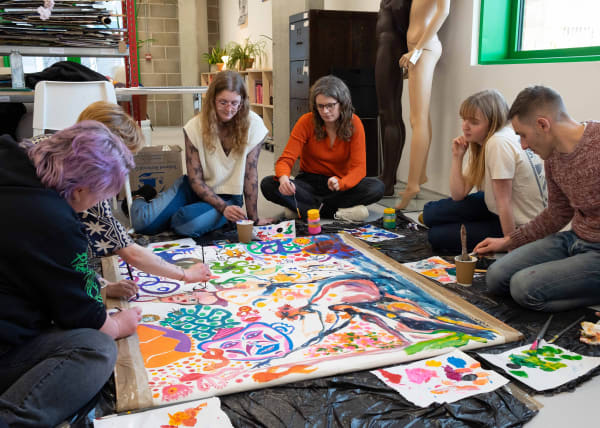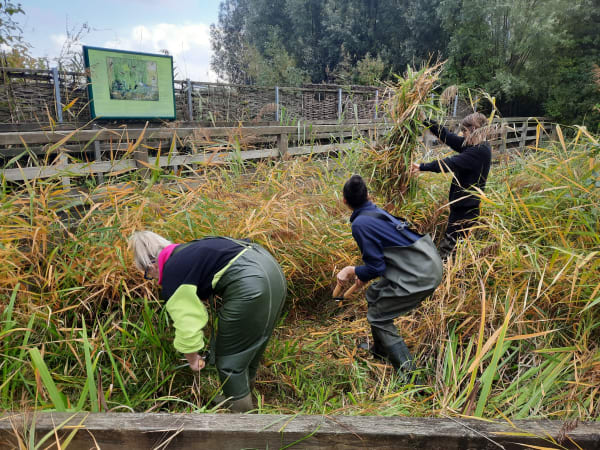-
Summing up the themes that this brief exploration of the QUEERCIRCLE’s ‘Make Time’ programme has uncovered, in response to the question “What else is made through making?”, this blog looks at the modes of working in these sessions, and frames some further insights into how participants have been making the range of positive personal gains touched on in the previous blogs.
The importance of QUEERCIRCLE as a unique kind of space was a theme that re-emerged many times. QUEERCIRCLE feels like a restorative space for many visitors, and participants often mentioned signing up because they felt depleted, exhausted, needed something. The mood or atmosphere on arriving at QUEERCIRCLE is described as calming and welcoming.
Artist facilitator Lady Kitt highlighted that a sense of shared core values is central to this calming effect for people. Entering QUEERCIRCLE from the outside world – particularly in a current society so paralysed by binary divides in people’s values and beliefs – can immediately feel like a release of tensions. This sense of a strong ‘ethical’ scaffold provided by a set of core values can then allow participants to explore creative frictions or other kinds of diversity within the QUEERCIRCLE community.
-

-
Pathways to feeling restored
-
So if one overarching positive outcome for participants is that they feel refreshed, strengthened, more connected after taking part in QUEERCIRCLE ‘Make Time’ sessions, what kinds of communication modes or languages are contributing to this? Research interviewees offered a range of modes they had experienced in workshops:
● Non-verbal shared time or collaboration
● Meditative practice – going inward to communicate with ourselves
● Somatic communication as a group – dance, movement, yoga...
● Gifting, reciprocity, care between collaborating participants
● Playfulness and play
● Creative and imaginative processes, including metaphor.
The latter was described by Shakthi who recalled one of Lady Kitt’s workshops:
“just doing it as the threads dictated, it felt like following the journey of life... When the thread tangled, they recalled certain obstacles they faced in their life, and when the thread was woven across two large objects it recalled the experience of their life coming into contact with another person or forging some relationship.... the experience of their tangles and so forth being like life where you can’t really untangle what has happened in the past, you just have to kind of move forward... How it worked better when they embraced the tangle” -Shakhti
-
In his own writing, artist facilitator Terence Wilde also drew on metaphor to explain a physical and emotional resonance between sewing and stress release: “There is a pressure applied in pulling and pushing threads through fabric, a routine of releasing and controlling pressure, that mirrors the internal balancing of tension within the sewer themselves.” - Terence
Amongst all the varied creative making practices that were offered as part of the QUEERCIRCLE ‘Make Time’ programme, two ideas stand out for me that encapsulate many others.
Firstly, all the sessions offered ways to move between these multiple modes of communication, and along with them, to move between multiple ways of being together, multiple ways of knowing or understanding what it is to be human, and to live a life. Moving between these modes within a single session and making these translations or transitions together with other participants (known or unknown) seemed to offer participants release, communion, and new challenges and insights. In short – to grow.
-
Secondly, and finally, there is a specific thread of purpose amongst the participants in activities at QUEERCIRCLE, namely the intention to make change in the world – at a personal level or at a socio-political level. Lady Kitt crystalised a beautiful explanation of the way in which ‘creative making’ in a workshop can be a metaphor for another level of ‘making’ in the world:
“Physically making things together changes the dynamic in a group. It’s different from just having a conversation, it’s realising we have ‘material agency’. It’s a physical manifestation of our agency to change things...” – Lady Kitt
It’s no wonder that participants can feel lifted and even empowered by taking part in creative making activities at QUEERCIRCLE if, as these blogs have explored, so many aspects of being alive, feeling affirmed and feeling connected are in play for them. Then add in that we are reminding ourselves that making change in the world is a habit we can practise and build, through participating in ‘Make Time’: and ultimately it seems clear that ‘creative making’ at QUEERCIRCLE offers participants a feast of non-material benefits to complement whatever artworks the workshop process creates.




